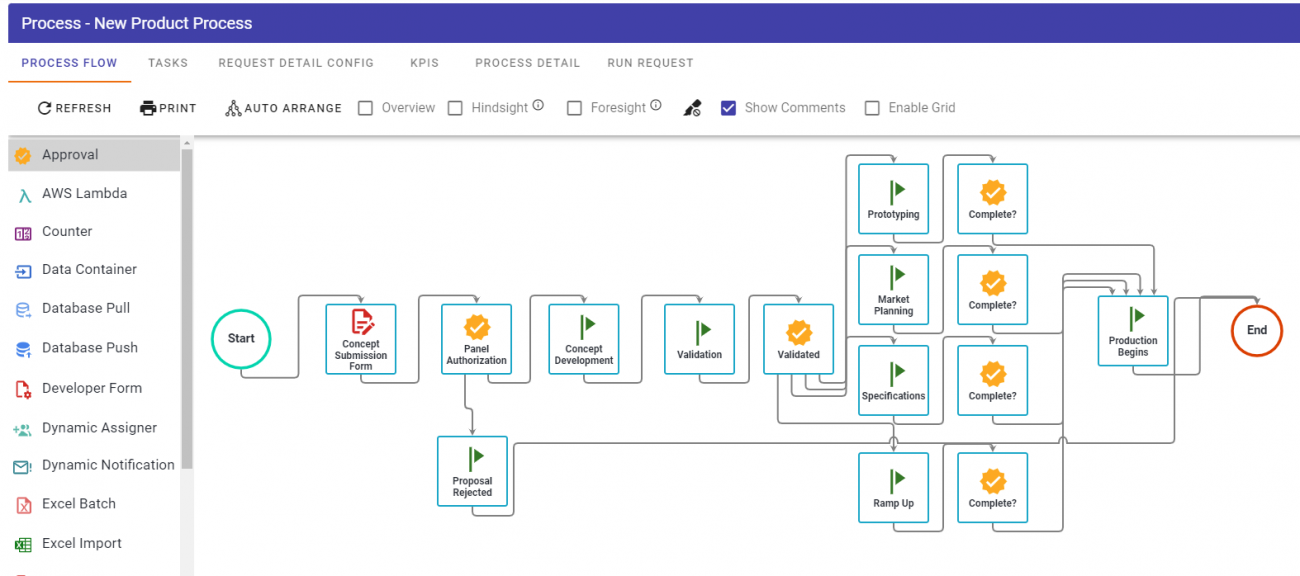Product Development Process
The product development process can be automated for greater efficiency and quality.

Benefits of Automating Product Development
- Reduce Time to Market
- Quality Assurance
- Identify Process Bottlenecks and Stalls
- Reallocate Tasks in Real-Time
- Automatically Create Audit Trails
- Improve Team Focus and Consistency
- Reduced Project Shortcutting
- Reduced Rework
While new products may be unique, the methodologies and activities involved in developing them are often repeatable and can be automated. The tasks and processes required to develop products and services can be standardized and made actionable while allowing creativity within the framework.
Product Development Stages
The stages vary greatly depending on the organization's size, the type of product (incremental, breakthrough, etc.), and the products being developed. Some processes may have seven stages, others may have dozens. The new product development process is unique to every organization. However, many of the stages are common.
For instance, for a manufactured product, the process might look something like this:
- Ideation
- Concept Submission
- Authorization (Often an interdisciplinary management team)
- Concept Development/Research
- Validation (Market/Customers)
- Prototyping
- Market Planning
- Specifications
- Ramp-Up and Preparation
- Final Testing
- Production
- Improvement
Automating the Product Development Process
Using a workflow automation tool, each development phase is broken down into the tasks that need to be performed. These tasks are laid out visually to represent the entire process from beginning to end, in the order they need to be completed. The tasks are then assigned to individuals or product teams, who can see the overall progress of the project, previous steps, and what comes next. They can also receive notifications and reminders at negotiated intervals to keep work flowing forward.

Benefits of Automation
Automation can provide speed and improved quality in the product development process; it also provides a framework for both creatives and engineers to focus on their work rather than the process. Let's take a look at all the benefits.
- Reduce Time to Market: Streamlined process, reduced redundancy, reduced administration time, clearer communication.
- Quality Assurance: Improved oversight, enforced checkpoints, and skill-based review assignments.
- Identify Process Bottlenecks and Stalls: Process transparency, workflow analytics, KPI tracking, task reminders, and escalations.
- Reallocate Tasks in Real-Time: Task reassignments, automated escalations, alternate assignment settings.
- Automatically Create Audit Trails: Activity tracking, timestamps, document retention.
- Improve Team Focus and Consistency: Process clarity, reduced emails/meetings/confusion.
- Reduced Project Shortcutting: Standardized procedures, non-compliance flagging.
- Reduced Rework: Required fields/attachments, standardized forms, consistent checkpoints.
Best Practices for Automating Product Development
- Build scorecards or use a ranked scoring system to evaluate ideas.
- Allow managers to reallocate work for stalled projects.
- Handling non-linear processes by running child processes concurrently or launching separate processes.
- Include documentation and videos on forms, reviews, etc., so users can make better decisions.
- Assign approval tasks to a group and require all members to sign off before moving forward.
The Tools to Supercharge the Product Development Process
Process Builder
Our visual process designer interface lets you design product development workflows using drag and drop. Automatically assign tasks and route information based on your organization's unique product design workflow. Set alerts, reminders, and escalations to keep projects moving forward.
Form Designer
Easily create responsive, Web-based forms to capture product ideas and improvements. Include various field types, form logic, templates, and layouts to ensure the correct data is captured and routed every time.
Self-Service Portal
Provide a unified front-end experience that allows users to submit product idea forms, track customer suggestions, complete reviews/approvals, and track process status. Collaborate in real-time about work being performed. Provide visibility by role to see which tasks are completed, pending, or in progress for a great user experience.
Process Reporting
Track and maintain an audit trail of all your product design workflows, including form data, users, and tasks performed. Follow product team progress and use KPI scoreboards to track the overall efficiency and drive improvements. Build custom reports to analyze and share with stakeholders.
Process Integration (API)
Create workflow applications with process integration into existing enterprise systems. Our open architecture and standalone web service allow other applications to initiate a workflow, complete a list of tasks, update process statuses, and conduct other bi-directional activities. Connect everything with Integrify.
Interested in Automating Your Product Development Workflow?
We have a variety of resources to help you on your journey to an automated workflow.
Don't Stop at Product Development...
Why not automate all your processes?
Integrify's open, low-code process automation platform lets you automate any process. Build as many processes as you want, you only pay for the number of users.